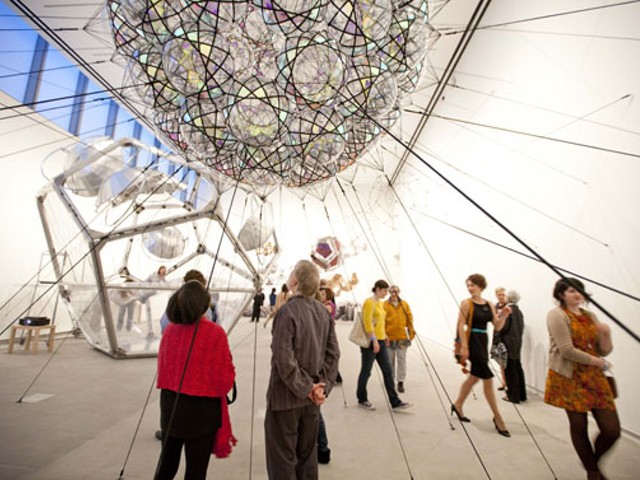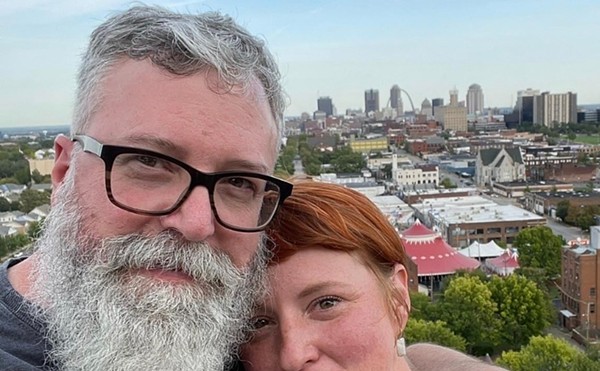Newly Reviewed
Doing Easy In a riff on William S. Burroughs' Zen manual-like story, "The Discipline of DE," which details the fastidiousness that underlies effortless-seeming cool, Cole Root assembles a group show of disparate work by Glen Fogel, Dani Kantrowitz, Gregg Louis, Mike Schuh and Matthew Strauss. What does it mean to "do easy"? It means setting down a fork without it clattering, landing each crumpled and thrown wad of paper in the wastebasket, gripping items with the right force so they don't spill or shatter. In the art studio, DE seems to function as a metaphor for the hermetic agony that precedes the creation of works that, when complete, appear like foregone conclusions. Kantrowitz contributes a series of found photographs that depict the interior of a middle-aged man's home, juxtaposing the impersonal and the intimate to jarring effect: the recurring appearance, for instance, of a pair of Bert and Ernie dolls amid otherwise banal décor. Normal is never normal enough. Fogel's milieu here is the subway platform, where he has snapped cell-phone pics of ads that have been tweaked by bored commuters or general wear and tear: grim Marines sporting Sharpie-drawn fangs; glossy-haired models whose visages have been torn out and supplanted by that of Kanye West. Schuh's work suggests a mind exposed to reveal its makeshift internal wiring and idiosyncratic infrastructure. An example: A utility bucket, flipped upside down, sits on a white pedestal with a chunk of cracked concrete resting on top and a vintage postcard of the inside of a cave folded in half and perched like a crown at the piece's apex. A sense of logic informs the work's unexpected disjunctions, mixing a kind of pragmatic poeticism with a dash of self-mockery: It's an absurd totem to absurdity at its best. Louis' piece — two sheets of paper upon which the word "simultaneous" is scrawled — was executed in precisely that manner: by both hands, at once. This exercise in deliberately useless prowess examines self-critique from further afield: What's the value of such an accomplishment without a witness? In this way Doing Easy wittily vivisects the elegance and mild tragedy inherent in any attempt at crafting a sense of self: Sometimes you land the trash in the can, sometimes you miss, sometimes no one notices or cares. Through October 15 at Los Caminos, 2649 Cherokee Street; www.loscaminosart.com. Hours: by appointment. (Editor's note: Visual arts writer Jessica Baran is the assistant director of Matthew Strauss' art gallery, White Flag Projects.)
Featured Review: Tomás Saraceno: Cloud-Specific Working at the impossible intersection of pragmatism and practicality, Argentinean-born, Frankfurt-based artist and architect Tomás Saraceno creates prototypes for a future city in the sky, a buoyant cloud of molecule-like modules amiably drifting above the overburdened environs below. In this installation Saraceno presents a massive aluminum framework encasing a similarly massive clear-plastic bubble. Viewers are invited to climb inside (after divesting themselves of shoes, rings, keys — anything that might pop Saraceno's balloon), lie on their backs and admire the silver solar cookers affixed to the capsule's upper regions or peruse one of Saraceno's source texts: The Cloudspotter's Guide, Biology of Spiders and R. Buckminster Fuller's seminal essay Operating Manual for Spaceship Earth. The reclining visitor may also take in the view of the gallery outside Saraceno's One Cloud Module: a cluster of iridescent bubbles that resemble Gothic stained glass, bound in black webbing and elastic ropes; a massive mural depicting a model cloud city, with our digitally rendered descendants in their modules, going about their daily tasks; a video projected on another wall that shows Saraceno and a team of collaborators attempting to send aloft his tessellated objects in the manner of NASA test flights. At once whimsical, revolutionary and nostalgic, the work hovers between the absurdly cerebral and the elementally alluring. It's hard not to succumb to the artist's ambitious vision while you're lying on a cloud and contemplating the sky. Through January 9, 2012, at the Mildred Lane Kemper Art Museum, Forsyth and Skinker boulevards (on the campus of Washington University); 314-935-4523 or www.kemperartmuseum.wustl.edu. Hours: 11 a.m.-6 p.m. daily (closed Tue., open till 8 p.m. Fri.).
OngoingExposure 14 Nature is a durable muse. So says the work of the three artists selected for this year's annual local showcase, Exposure, hosted since 2005 at UMSL's Gallery 210. Brigham Dimick's pieces are literally infested with natural life: Bees inhabit a series of observation hives in which the artist's portrait, encased in wax, is slowly devoured by the insects. The oak-framed contraptions take on the form of altarpieces — a deeply unsettling take on the notion of the iconic. Greg Edmondson's meticulous pencil-on-vellum drawings trace the microscopic patterns of plant species, distilling their self-organizing systems to undulating abstractions. A procedural dimension informs the work, which is at once taut and diaphanously delicate. This temporal aspect is explored in two videos — one consists of the slow phases of the moon; the other features various drawings infinitely interlocking — that reinforce via metaphor the elegant relentlessness of the artist's painstaking approach. Ronald Leax's medium is the common Petri dish, arrays of which he mounts on paper in grid-like fashion, dates and stamps as "specimens," and encloses in frames. The dishes contain organic cultures in advanced stages of luminous decomposition: the peculiar aesthetics of science itself, in its most minimally adulterated state. Cumulatively, the works' slippage between science-as-art and art-as-science speaks to a kind of longing: In his unstinting, solitary experiments, the artist yearns to produce something of lasting and vital utility, something less like art and more like a cure. Through October 1 at Gallery 210, TeleCommunity Center, University of Missouri-St. Louis, 1 University Drive (at Natural Bridge Road); 314-516-5976 or www.umsl.edu/˜gallery. Gallery hours: 11 a.m.-5 p.m. Tue.-Sat.
Four Chapters in the Present We Were After interviewing a passel of Americans old enough to possess memories of World War II, the Kennedy assassination, the 1969 Apollo moon landing and 9/11, artist Lisa Bulawsky has crafted a trenchant series of prints rooted in those recollections. An ironing board and button down-shirt bear the faint residue of bloodshed; Wonder bread's primary-hued polka dots intermingle with pages from a handwritten journal and mirror the red bullet holes that dot an adjacent print; gas-rationing coupons float above piles of foil-wrapped Hershey's Kisses and Morse code messages rendered in red — here history is grafted upon the quotidian, reversing the conventional hierarchy wherein the personal becomes secondary to the national. This version of the past, etched in hand-drawn marks and collaged ephemera, presents itself like a new memory recalled, inviting viewers to revisit their own sense of the not-too-distant past. An empathetic listener and observer, Bulawsky summons images as diverse as fighter planes and the broken yellow line that divides some stretches of highway, in order to get a firmer grip on what it means to be "American." The long and deep stream of her interview subjects' consciousness places more-recent watershed events in a context less often considered — i.e., one of perpetual warfare and struggle accompanied by human ingenuity and making-the-best-of-it goodwill. Walking through the exhibit is like rerunning a dream: an unfolding of familiar tragic subtext shot through with buoyant and freshly discovered humanity. Through October 16 at the Millstone Gallery at COCA, 524 Trinity Avenue, University City; 314-725-6555 or www.cocastl.org. Hours: 10 a.m.-5 p.m. Mon.-Fri., noon-5 p.m. Sat.-Sun.
David Noonan The extent to which the world is a stage and all of us mere actors is wisdom darkly revisited in this solo exhibition of recent works by London-based Australian artist David Noonan. Using found imagery of theatrical performances from the '60s and '70s, Noonan creates large-scale screen prints on linen that's patched together in textures that recall Japanese Boro textiles (an intuitive patchwork clothing style from the late 19th century). Noonan constrains his palette to inky black and the earthen tones of the fabric, which imbues his works with a saturated, macabre character, amplified by the black-painted eyes and mouths of the sinister performers he depicts. Suggestive of extreme avant-gardism and occult ritual, the players in these fractured scenes are at once frozen in bizarre contortions and animated by the frayed and tactile nature of their substance: The torn swaths of linen beg to be touched, if not worn, like a costume. Abstract patterns printed over the images underscore the work's identity as fabric and artifact of the past, resembling both stitch lines and the marks of distress. A roomful of just-beyond-life-size dancers, also printed on linen but affixed to freestanding pieces of wood cut to the figures' silhouettes, is more physically confrontational in real time. The specter of the past — when experimentalists' utopian aspirations were sincere and hopeful — thickly permeates the show like a sinister symbol of misguided folly, vain indulgence or worse. Also showing: Sick Serena and Dregs and Wreck and Wreck In this Gothic-inspired 16mm film, British artist Emily Wardill uses the morality-tale paradigm as an absurdist analogy for the mis-education espoused by contemporary media, wherein the common phrases we use to communicate with one another (e.g., "sex and drugs and rock & roll," which is mangled and re-imagined as the film's title) are reduced to hollow rituals and empty acts of aimless devotion. Through December 30 at the Contemporary Art Museum St. Louis, 3750 Washington Boulevard; 314-535-4660 or www.camstl.org. Hours: 10 a.m.-5 p.m. Wed.-Sat., 11 a.m.-4 p.m. Sun.
Out of the Box: Artists Play Chess To inaugurate the contemporary gallery in the newly minted World Chess Hall of Fame, Bradley Bailey has curated a thoughtful yet cacophonous exhibit of 21st-century artworks that exploit the cerebral game's sculptural and conceptual possibilities. Drawing on chess' militaristic identity, the exhibit abounds with warring audio tracks — Liliya Lifánova's expertly stitched costumes from an interpretative live performance of the game may hang empty and mute, but video footage of the event booms with moans and growls. Barbara Kruger's Untitled (Do you feel comfortable losing?) chess set is literally chatty: When moved, the game pieces shout everything from insults to metaphysical queries. Diana Thater restages a famous 1920 match between chess showman Georges Koltanowski and conceptual artist/chess enthusiast Marcel Duchamp (the artist won): Two female chess novices re-enact the moves on four video screens, the action and audio twitching at a frenetically sped-up pace, the twice-bisected image nearing abstraction. Looking on as a mute foil, Yoko Ono's all-white chess board, Play It by Trust, suggests there's an antidote to all the heady antagonism: communication and collaboration. And St. Louis native Tom Friedman offers another pacific salve: sheer absurdity. His fantastically bizarre and meticulous set — composed of 32 unique pieces that come in such divergent forms as a can of Michelob and a booger — confounds any attempt at studied fastidiousness, even as it creates the most impossible game of all. Through February 12, 2012, at the World Chess Hall of Fame, 4652 Maryland Avenue; 314-367-9243 or www.worldchesshof.org. Hours: 10 a.m.-5 p.m. Wed. and Sat., 10 a.m.-8 p.m. Thu.-Fri. and noon-5 p.m. Sun.





